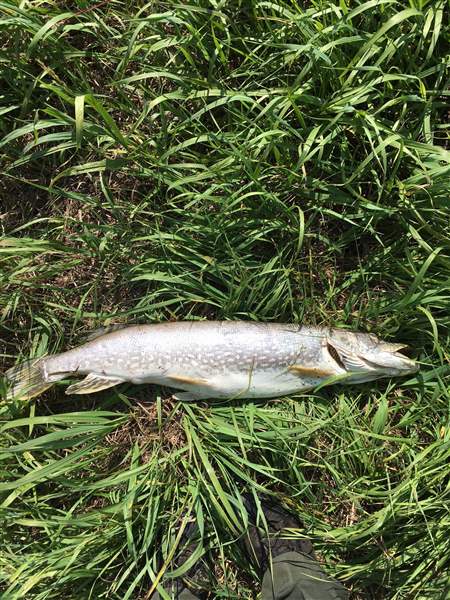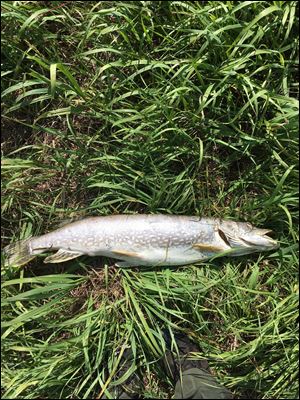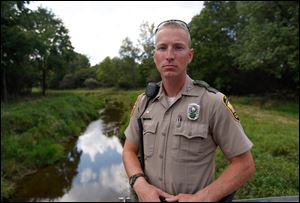
Authorities investigate death of thousands of fish in Williams County
8/23/2017
Manure spread across more than 100 acres of farmland just before a major thunderstorm rolled in killed close to 15,000 fish in Williams County’s Beaver Creek.
ODNR Division of Wildlife District 2 Unit A

Manure spread across more than 100 acres of farmland just before a major thunderstorm rolled in killed close to 15,000 fish in Williams County’s Beaver Creek.
WEST JEFFERSON, Ohio — Manure spread across more than 100 acres of farmland just before a major thunderstorm rolled in killed “close to 15,000” fish in eastern Williams County’s picturesque Beaver Creek, raising new questions about the strength of rules governing fertilizer application and how well farmers are following them.
The incident is one of at least three in northwest Ohio being investigated by the Ohio Department of Natural Resources, the state Department of Agriculture, the state Environmental Protection Agency, and local soil and water conservation districts.
Jeremy Payne, chief wildlife investigator for the Ohio DNR’s District 2 office that covers much of northwest Ohio, told The Blade on Wednesday that 36,800 fish died in Allen County’s Jennings Creek on Aug. 6 and 14,600 fish died in a Hardin County stream on Aug. 4, much in the same manner that the Williams County fish died on Aug. 17.
RELATED: Blade editorial forum on water quality, agricultural fertilizers
An additional case is being investigated in Mercer County, although Mr. Payne said that one is in another district. Information about it was not immediately available.
In each case, manure was spread too close to the arrival of a major thunderstorm. Ammonia from the animal waste flowed into nearby creeks, sucking oxygen from the water and leaving fish dead.
VIDEO: Anthony Lemle, Ohio Division of Wildlife

Ohio Division of Wildlife officer Anthony Lemle, next to Beaver Creek near West Jefferson, Ohio on August 23. Fish in the creek were killed after a significant rain event flooded manure into the creek.
The carnage in Williams County wasn’t immediately known, because Beaver Creek’s water level was too high to do an immediate assessment after the storm, officials said.
The creek was hit by an unusually heavy storm that dumped 2.5 inches of rain on it within hours on Aug. 17.
Anthony Lemle, Ohio DNR state wildlife officer assigned to Williams County, said a local citizen reported dead fish along the Beaver Creek shoreline on Friday. Mr. Lemle was one of nine Ohio DNR officers who scoured nearly 10 miles of the creek near West Jefferson, but had to wait until Saturday to begin their assessment because the creek was holding an unusual amount of water.
When asked how many fish were killed in Williams County, Mr. Payne replied: “Close to 15,000.”
State rules that took effect on July 3, 2015, prohibit manure from being spread when there is a greater than 50 percent chance more than a half-inch of rain will fall within 24 hours. Investigators are trying to determine if fertilizer applicators in each situation disobeyed those rules — or if the fish kills were from freakishly heavy downpours in isolated areas, as sometimes happens despite best weather predictions for a region.
“I think it’s a freak [of nature] that amount of rain fell in that one spot. All of Williams County did not get 2.5 inches,” Mr. Payne said. “Did they know some rain was coming, though? That’s what we’re looking into.”
The Ohio DNR believes it knows who spread the manure in at least a couple of cases, including the one in Williams County, but are withholding information about the applicator and the crop field where it was spread pending the investigation. Violations have not been filed in any of the cases yet, he said.
Under a worst-case scenario, someone found in violation of the rules could be ordered to pay the state of Ohio restitution for the fish kills and face either criminal or civil penalties, he said.
“Every dead fish has a value of some sort,” Mr. Payne said.
He said it is unclear if the manure was generated by a livestock facility large enough to be classified as a concentrated animal feeding operation, or CAFO, or if it came from some other type of operation, including one of the many dozens of farms that keep their animal herds just under the CAFO-permitting threshold.

“I don’t know where the manure came from at this point,” Mr. Payne said.
Typically, livestock farmers contract out manure application to others, who spread it on nearby crop fields as part of the industry’s state-approved manure management plans. Those plans are kept secret, because the agriculture industry fears farmers taking the manure will be harassed.
Environmental groups nationwide have called upon stricter controls for manure management, especially as the agricultural industry becomes more consolidated. Farmers are under pressure to produce more meat and crops on less land as Earth’s population continues to expand, the planet’s climate warms, and rural areas become paved with more development.
The concerns have been amplified in the western Lake Erie region in response to the 2014 crisis in which nearly 500,000 Toledo-area residents were warned to stay away from their tap water for nearly three days because of an algal toxin that had temporarily poisoned the water.
Former Toledo City Councilman and two-time mayoral candidate Mike Ferner launched a group called Advocates for a Clean Lake Erie in response to that crisis. It calls for stronger CAFO rules, better manure management, and an impairment status for Lake Erie’s open water in hopes of achieving those two objectives.
“This is absolutely, 100 percent, a discharge into the waters of the U.S. and is a violation of the Clean Water Act,” Mr. Ferner said. “And we demand an immediate investigation using DNA tests. We need to know where this came from and hold the polluters strictly accountable. Not only has this polluter killed untold numbers of fish, but its toxic plume is on the way to Lake Erie where our drinking water comes from.”
Most fish-kill events tend to occur in August, when temperatures rise and creeks are shallow, Mr. Payne said.
Beaver Creek was shallow again on Wednesday, following several days of little or no rain.
“This is the time of year. There’s a lot of manure being spread on fields,” Mr. Lemle said.
Beaver Creek is normally used by smaller fish because of its shallowness. Minnows, sunfish, and bullhead were among those killed last week, but there also were some large northern pike, Mr. Lemle said.
He said he counted 800 dead fish himself.
Fertilizer in that area either flows off the surface of fields or through tiles beneath the surface. Many of those tiles drain directly into Beaver Creek.
Most fish that weren’t recovered have mostly decayed at the bottom of the creek, Mr. Lemle said.
The Ohio Department of Agriculture, which regulates farms that produce manure, will decide what course of action to take once more is known about the investigation, Brett Gates, ODA deputy communications director, said.
The Ohio EPA has had staffers visit the site, and has initiated an investigation into potential violations, agency spokesman James Lee said.
Contact Tom Henry at thenry@theblade.com, 419-724-6079 or via Twitter @ecowriterohio.